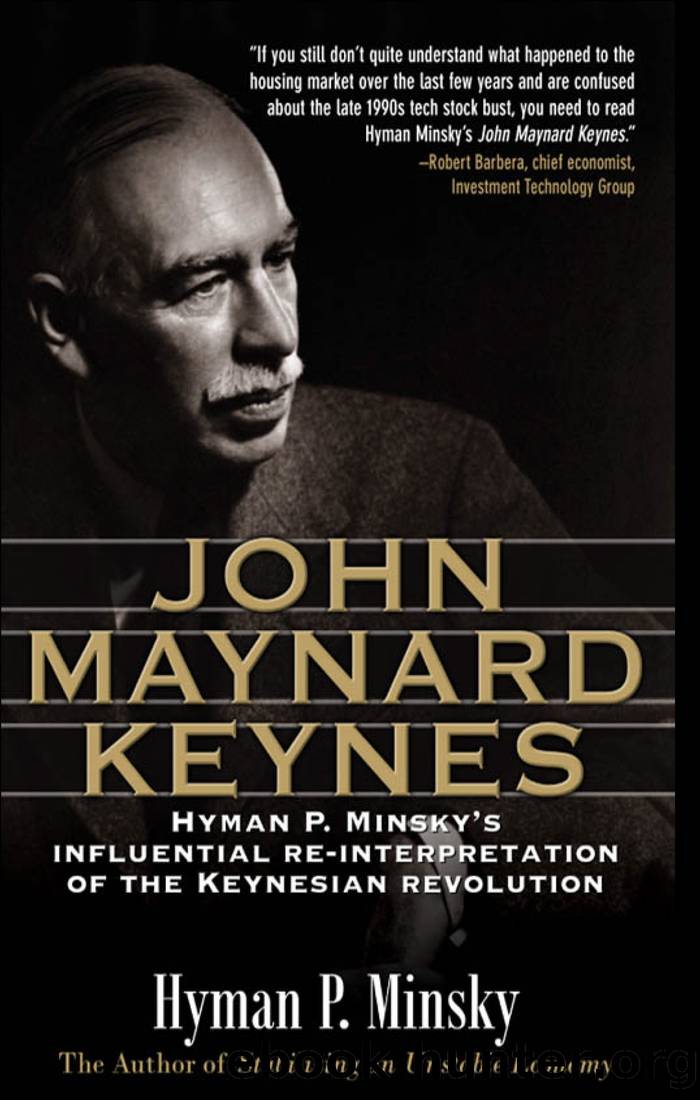John Maynard Keynes by Hyman P. Minsky

Author:Hyman P. Minsky
Language: eng
Format: epub, pdf
Publisher: McGraw Hill LLC
Published: 2008-06-15T00:00:00+00:00
Diagram 4.1: Cost Curves
Profit-maximizing output of the firm is OOâ². The difference between total receipts and total variable cost is the quasi-rent. In diagram 4.1, OC Ã OOâ² is the total revenue and OA Ã OOâ² is the total variable costs. The shaded area ACCâ²Aâ² is the quasi-rent, Keynes's q. If this firm has a debt structure, then over the period covered by the diagram, cash interest payments will be required. The interest payments are presumably independent of output; thus AVC plus interest is derived by adding total interest charges to the total variable costs. The area ABBâ²Aâ² represents the interest paymentsâin our interpretation, the c of Keynes. The difference between the gross quasi-rents and the interest payment is the gross profits before taxes.
If the debt contract provides for a sinking fund or includes some amortization of the principal of the debt, then the cash-payment requirements will be greater than the pure interest charge ABBâ²Aâ². Such financial considerations force the firm to use some of its gross profits before taxes to meet financial commitments. In fact if the financial contracts are sufficiently short, then the cash payments on financial contracts can exceed the total quasi-rents. The implications of this possible situation for the firm and for financial markets will be considered in what follows.
Thus q, the quasi-rent, is a cash flow that is independent of the liability structure of the producing unit. This is the concept of income used in determining the market value of the underlying physical assets. Presumably, in a perfect capital market, where uncertainty and liquidity do not affect the valuation of assets, q â c capitalized would equal the market value of equities, c capitalized would equal the market value of debts, and the sum of the two would be invariant and equal to the capitalized value of q; that is, debt structure would not affect the valuation of a firm. For purposes of valuing liquidity in a cyclical context, the cash-flow concept for a firm must allow for financing charges and tax liabilities.
Keynes recognized that the stock of liquid goods entails wastage and carrying costs. He uses wheat as his exampleâfully realizing that the expected appreciation of wheat prices, which is necessary if it is to be profitable to hold wheat, must be large enough to compensate for wastage, storage-facility rental, and interest on the cost of the wheat over the period wheat is carried. Certainly if one thinks of carrying stocks such as wheat, one thinks of the financing charges. But this is not explicitly mentioned in chapter 17, although the money rate of interest is used in the example (GT, p. 233) in which Keynes determines the wheat rate of interest.
Consider a pure instrumental capital, yielding a quasi-rent, q, and a pure stock of liquid goods, the ownership of which entails a carrying cost, c. For liquid-stock items, the current demand price must be sufficiently below the expected market price at the end of the carrying period so that the expected capital appreciation will more than offset the financing costs and the wastage.
Download
This site does not store any files on its server. We only index and link to content provided by other sites. Please contact the content providers to delete copyright contents if any and email us, we'll remove relevant links or contents immediately.
International Integration of the Brazilian Economy by Elias C. Grivoyannis(91521)
The Radium Girls by Kate Moore(11927)
Turbulence by E. J. Noyes(7941)
Nudge - Improving Decisions about Health, Wealth, and Happiness by Thaler Sunstein(7622)
The Black Swan by Nassim Nicholas Taleb(7016)
Rich Dad Poor Dad by Robert T. Kiyosaki(6413)
Pioneering Portfolio Management by David F. Swensen(6229)
Man-made Catastrophes and Risk Information Concealment by Dmitry Chernov & Didier Sornette(5924)
Zero to One by Peter Thiel(5690)
Secrecy World by Jake Bernstein(4651)
Millionaire: The Philanderer, Gambler, and Duelist Who Invented Modern Finance by Janet Gleeson(4382)
The Age of Surveillance Capitalism by Shoshana Zuboff(4214)
Skin in the Game by Nassim Nicholas Taleb(4165)
Bullshit Jobs by David Graeber(4100)
The Money Culture by Michael Lewis(4082)
Skin in the Game: Hidden Asymmetries in Daily Life by Nassim Nicholas Taleb(3935)
The Dhandho Investor by Mohnish Pabrai(3705)
The Wisdom of Finance by Mihir Desai(3658)
Blockchain Basics by Daniel Drescher(3511)
